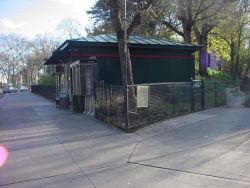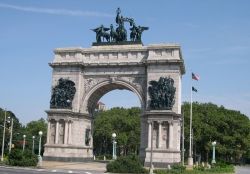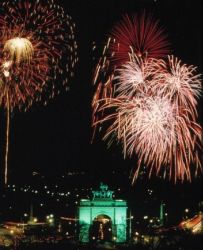Grand Army Plaza
View all monuments in NYC Parks, as well as temporary public art installations on our NYC Public Art Map and Guide.
Henry W. Maxwell Memorial
| Artist: | Augustus Saint-Gaudens, Albert Jaegers |
| Dedicated: | June 25, 1996 |
| Location: | Plaza Street and St. Johns Place |
Artwork History
This bronze relief tablet by Augustus Saint-Gaudens (1848-1907) honors Henry Maxwell (1850-1902), a Brooklyn-based banker, philanthropist and supporter of public education. Born on December 17, 1850, Maxwell spent most of his life in his native Brooklyn and attended Public School 15. He distinguished himself in the business world as a partner in the Maxwell and Graves Bank and as director of several corporations, including the Brooklyn Trust Company and Liberty National Bank.
Maxwell did not just make money; he gave it away. He was a member of numerous local charities, and contributed funds for the erection of Memorial Industrial School No. 2, an addition to the Brooklyn Industrial School System, which he dedicated to his mother and wife. It was said that he believed “in good government and pure politics”. He was a commissioner on the Brooklyn Park Commission in 1884, and for many years a member of the Board of Education. One of Brooklyn’s most public-spirited citizens, he also “gave freely of his wealth” to the Brooklyn Institute of Arts and Sciences (on whose board he sat from 1894-1900), the Home for Destitute Children, and Long Island College Hospital. His active social life included membership in the Hamilton and Excelsior Clubs.
Upon his death, friends and colleagues of Maxwell, in acknowledgment of his achievements, commissioned the medallion portrait by Saint-Gaudens, who was assisted at his studio in Cornish, New Hampshire by Albert Jaegers. Saint-Gaudens, whose better-known local works include the Admiral Farragut statue (1881) in Madison Square Park, and the General Sherman equestrian sculpture (1903) in Grand Army Plaza, Manhattan, created a sensitive high-relief depiction of Maxwell framed by ribbon-like garlands. The large tablet was affixed to a monumental boulder of pink granite weighing some twenty tons. Draped in a large American flag, the monument was unveiled by Maxwell’s niece, Mrs. Howard Whitney, on December 26, 1903.
The monument was originally located at the intersection of Eastern Parkway and Flatbush Avenue, adjacent to the Mt. Prospect Reservoir. Once known as Sunset Park, the property is now the site of the Brooklyn Central Library. Due to the construction of the library, in 1912 the monument was relocated to its present location at the hillside berm nearby at Plaza Street East and St. John’s Place. It reportedly took a week and ten horses to move the massive boulder across the street.
Over time, the plantings around the monument grew quite dense and the artwork was the object of repeated vandalism. The tablet was removed to NYC Parks storage in the early 1970s for safekeeping. In 1997, through the initiative and financial support of the David Schwartz Foundation, restoration work was completed on the original tablet. The piece was repaired, re-patined and conserved, and loaned to the Brooklyn Museum of Art, where it is now displayed at the museum’s south entrance. Two replicas of the tablet were made, one of which was reinstalled in the original boulder, and the other is displayed at the Saint-Gaudens National Historic Site in Cornish, New Hampshire.
Artwork Details
| Description: | Plaque with bas-relief roundel on boulder. Replica of original which is now at the Brooklyn Museum |
| Materials: | Bronze, granite |
| Dimensions: | Plaque H: 4'3¼" W: 3'1½" D: 1¼"; Boulder H: 8' W: 6' |
| Fabricator: | Modern Art Foundry |
| Donor: | David Schwartz Foundation |
| Cast: | 1996 |
Inscription
1) around top of roundel: "MDCCCL HENRY W. MAXWELL MCMII"2. below roundel: "THIS MEMORIAL ERECTED BY HIS/ FRIENDS IS THEIR TRIBUTE TO HIS / DEVOTION TO PUBLIC EDUCATION AND / CHARITY IN THE CITY OF BROOKLYN" /
3) signed: "A ST G"
Please note, the NAME field includes a primary designation as well as alternate namingsoften in common or popular usage. The DEDICATED field refers to the most recent dedication, most often, butnot necessarily the original dedication date. If the monument did not have a formal dedication, the yearlisted reflects the date of installation.
For more information, please contact Art & Antiquities at (212) 360-8163.
Check out your park's Vital Signs
Clean & Safe
Green & Resilient
Empowered & Engaged Users
Share your feedback or learn more about how this park is part of a
Vital Park System








